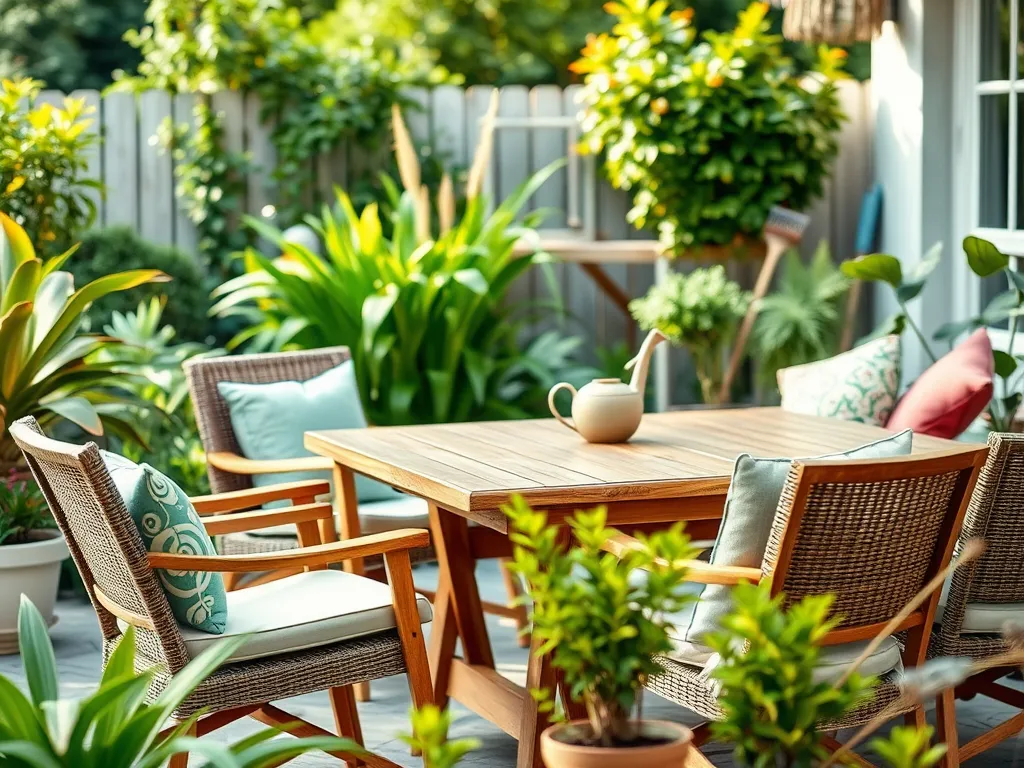Essential Guide: How to Maintain Outdoor Furniture

Ultimate Guide to Outdoor Furniture Maintenance
Outdoor Furniture Maintenance is essential for preserving the beauty and functionality of your outdoor spaces. Just like indoor furniture, outdoor furniture faces various elements such as sun, rain, and dirt, which can deteriorate its appearance and longevity. Regular maintenance ensures that your outdoor furniture remains a welcoming and comfortable place for relaxation and entertainment.
To achieve effective Outdoor Furniture Maintenance, it is crucial to understand the specific needs and material types of your furniture. By incorporating proper cleaning techniques, protective measures, and restorative practices, you can keep your outdoor pieces looking their best. This guide will walk you through all aspects of maintaining your outdoor furniture, ensuring it can withstand the test of time.
Understanding How to Maintain Outdoor Furniture is essential for extending its lifespan and preserving its aesthetic appeal.
Routine cleaning and maintenance can prevent the buildup of dirt and grime, which may cause irreversible damage. Additionally, understanding how to protect your furniture from environmental factors is key in extending its lifespan. Whether it's a garden bench, lounge chair, or dining set, every piece requires a personalized approach to upkeep as part of your Outdoor Furniture Maintenance strategy.
This guide will cover cleaning techniques, protective measures, restoration and repair tips, storage solutions, and insights into durability and lifespan. Making outdoor furniture care a priority ensures that your investments remain in top condition, ready for your enjoyment throughout the seasons.
Embracing the responsibilities of Outdoor Furniture Maintenance not only enhances the aesthetic appeal of your outdoor area but also contributes to a more sustainable living environment by prolonging the life of your furniture.
Cleaning Techniques for Outdoor Furniture
When it comes to cleaning outdoor furniture, using the right products is crucial. Look for specialized cleaners designed for specific materials, such as teak oil for wooden furniture or metal cleaners for aluminum and wrought iron pieces. Detergent mixed with water can work for most plastic and resin furniture, while faux wicker may require soft brushes to avoid damage.
Step-by-step, begin by dusting off any loose dirt and debris, followed by applying the appropriate cleaner. For wooden furniture, scrub gently with a soft-bristle brush and warm soapy water, rinse thoroughly, and dry with a towel. Metal furniture can be wiped down with a microfiber cloth after applying the cleaner. For plastic, a sponge can remove stubborn stains effectively. Rinse and dry all surfaces after cleaning for optimal results.
Outdoor cushions can suffer from stains due to food and drink spills. Removing stains may require a mixture of mild detergent and water, applying it directly to the stain. Let it sit for a few minutes, gently scrub, and rinse with cold water before air-drying in a shaded area to prevent fading.
To maintain the shine on metal furniture, consider using a dedicated metal polish post-cleaning. This not only enhances the shine but also creates a protective layer that can guard against rust or tarnish. Regular polishing, paired with a thorough cleaning schedule, will keep your metal pieces looking new.
For environmentally conscious homeowners, eco-friendly cleaning solutions may involve natural ingredients like vinegar and lemon juice, which can effectively clean and deodorize your outdoor furniture without harsh chemicals. These solutions are safe for the environment and can be complemented by biodegradable sponges and cloths.
Protective Measures for Outdoor Furniture
One of the best protective measures to consider for your outdoor furniture is investing in quality furniture covers. These covers shield your pieces from rain, sun, and dirt when not in use. Ensure that you select covers that are breathable to prevent moisture buildup underneath, which could lead to mold or mildew.
Selecting the right location for your furniture is equally essential. Place it in areas that provide shaded cover during peak sunlight hours. Avoid placing furniture directly under tree branches that could drop sap or debris, which can create staining or damage over time.
Seasonal maintenance plays a vital role in outdoor furniture upkeep. In the spring, inspect all pieces for any wear and tear from winter and apply protective finishes when necessary. During summer, regular cleaning prevents dirt buildup, while in fall, store or cover items to protect against leaves and moisture. Finally, winter should see furniture stored or covered to protect against frost and snow.
Applying protective finishes, such as sealants or varnishes, can add an extra layer of protection for wood and metal furniture. Make sure to follow the product’s instructions for application and reapplication for optimal results. This practice can greatly enhance the durability of your pieces.
Understanding weather effects on outdoor furniture can help you anticipate maintenance needs. For example, UV exposure can fade colors in fabrics and wood, while rain can cause wood to crack or warp if untreated. Know your local weather patterns and ensure to adjust your maintenance accordingly.
Restoration and Repair of Outdoor Furniture
Repairing damaged wood furniture involves assessing the degree of damage first. For minor scratches, a wood touch-up marker can work wonders. For deeper gouges, wood filler may be needed, followed by sanding and refinishing. If the wood has warped, clamping and re-securing it may restore its shape.
Reupholstering outdoor cushions may seem daunting, but it's quite manageable. Begin by removing the old fabric. Use it as a template to cut the new weather-resistant fabric to size. Staple or sew the new covering securely, ensuring that it fits snugly. Consider adding a layer of outdoor foam for added comfort.
Restoring paint on metal furniture entails first removing old paint layers through sanding or using a paint stripper. After prepping the surface, apply a primer to help the new paint adhere better before finally applying weather-resistant spray paint or outdoor-friendly latex paint for an enhanced finish.
DIY repairs for plastic outdoor furniture can often include using heat to gently reshape any bent areas or applying PVC glue to mend cracks. Relying on common household items, like duct tape for minor repairs, is also an option if you don't want a permanent fix just yet.
When to call a professional for repairs often comes down to the severity of the damage. If you're unsure how to handle intricate repairs, such as structural integrity issues, or if your furniture holds significant value, it's best to consult with a professional to avoid further damage.
Storage Solutions for Outdoor Furniture
For best practices related to winter storage, clean furniture thoroughly before storing it inside a shed, garage, or basement. If outside storage is necessary, ensure to use heavy-duty furniture covers that withstand various weather conditions. Elevate the furniture off the ground if possible to prevent moisture build-up.
Choosing the right storage location should focus on temperature control and avoidance of high humidity. Indoor storage is preferable, with well-ventilated spaces that can accommodate larger pieces of furniture without risking damage or wear.
When stacking outdoor furniture, ensure that heavier items are at the bottom to prevent damage to lighter pieces. Use furniture pads between stacked items to avoid scratching and maintain their integrity while maximizing your storage space.
During extreme weather, protecting furniture may involve moving pieces to sheltered areas or using tarps if they're left outside. Fastening covers securely will also help keep protective layers in place during strong winds to prevent shifting.
For space-saving storage options, consider multi-purpose furniture that can collapse or disassemble easily. Stacking chairs when not in use or selecting folding tables can save significant room and keep your outdoor area clutter-free.
Durability and Lifespan of Outdoor Furniture
Selecting durable materials for outdoor furniture plays a crucial role in its longevity. Opt for materials such as teak, eucalyptus, aluminum, or synthetic resin, as they can withstand weather extremes and resist wear and tear far better than cheaper alternatives.
Factors affecting the lifespan of outdoor pieces include exposure to sunlight, rainfall, maintained cleaning standards, and how often the furniture is used. Regular maintenance will play the most vital role in ensuring your furniture lasts longer, regardless of materials used.
How to test the quality of outdoor furniture can involve visual inspections for solid craftsmanship including hardware and joints. If available, checking the warranties offered by manufacturers can also provide insights into expected durability and lifespan.
Understanding warranties and guarantees is essential for consumers. Look for furniture products that offer warranties against defects in craftsmanship or materials, as they can ensure you receive quality and longevity
Signs that it's time to replace outdoor furniture may include extensive rust, rot, fading, or structural issues. If repairs are becoming cost-prohibitive or frequent, it's likely a smarter investment to seek out new pieces.
